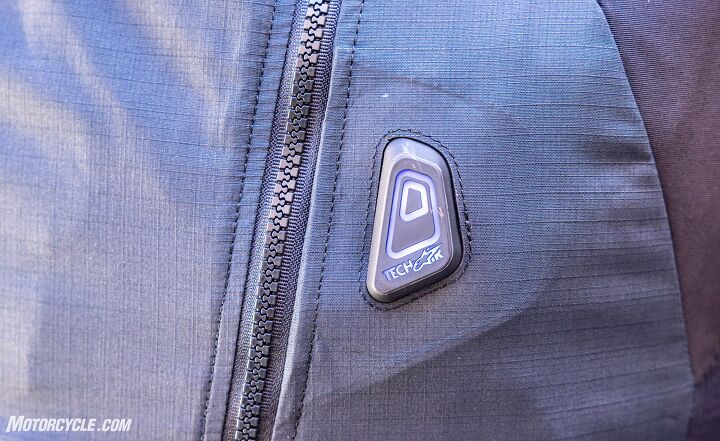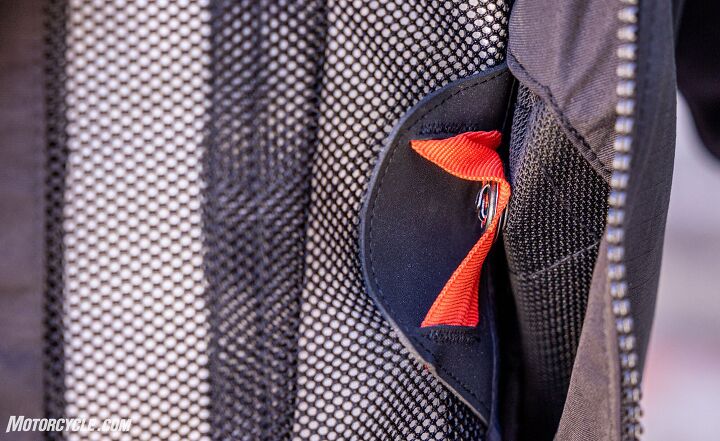Motorsports Racing News & Blog Articles
Best Motorcycle Airbag Jackets
Motorcycling airbags systems have now been in development for upward of 30 years. Companies like Alpinestars and Dainese have brought products to market, revised them, updated them, and developed new airbag systems to cover a broad range of motorcycling such as track riding, commuting, and off-road riding. We’ve seen these systems go from being integrated into specific garments, to standalone units that can be worn universally (with proper fitment). Now, we even have subscription-based systems that offer a lower barrier to entry price-wise than initially available.
Here at MO, we’ve done our best to cover the cutting edge of this technology as new products and airbags emerge. Heck, our own Troy Siahaan has proven himself time and time again to be a most excellent crash test dummy and because of this, he won’t be caught on two wheels without an airbag between him and impending doom. Do yourself a favor and read through Troy’s copious crash tested articles for first hand experience of airbag deployments. Due to his experience, I couldn’t think of a better person to lend a few keystrokes to this article.
Before we get into the five airbag systems we were able to test, we want to address the lack of a major player in the biz. We contacted Helite, which initially showed interest in being involved, but was then later unresponsive. Helite makes a range of airbag products from vests and jackets, to airbag backpacks, and now, airbag riding pants. All of the company’s current product line relies on mechanical tethers to the motorcycle which, when pulled, opens a CO2 cartridge which then deploys the airbag. There are other interesting features to Helite products and we are disappointed to have not been able to include them in this buyer’s guide.
While we know there are other companies out there, these were the latest products we were able to have on hand to review.
With all that said, let’s take a look at how airbags from the other major players stack up.
Table of Contents
Dainese Smart Jacket Hi Vis Alpinestars Tech Air 3 Alpinestars Tech Air 5 Alpinestars Tech Air 10 Klim In&Motion AI-1Dainese Smart Jacket Hi Vis
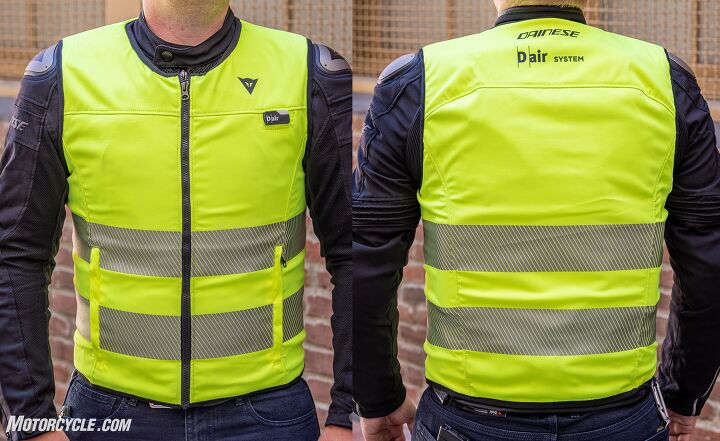
| MSRP | $830 |
|---|---|
| Sizes | Men’s XS-4XL, Women’s XS-2XL |
| Colors | Men’s Black & Yellow, Women’s Black |
| Battery Life | 26 hours |
| Weight | 4 pounds 4.7 ounces (1948 g) |
| Deployment Rate | 45 milliseconds |
| Modes | Street |
| Application | N/A |
| Maintenance | Check for updates periodically, Contact Dainese Technical Assistance once every 3 years to request a maintenance check |
| Reviewer | Ryan Adams |
The Dainese Smart Jacket was the first of its kind – a foldable, lightweight airbag vest that can be worn over or under a riding jacket. Previously, Dainese only offered systems built into race suits and various styles of jackets. While it still does offer these options, the Smart Jacket has now been added to its catalog.
The Smart Jacket’s airbag – which deploys in approximately 45 milliseconds (the average blink of an eye is 100 milliseconds) – covers the back, collar bones, and upper chest and uses microfilament technology. Dainese claims the microfilaments connecting the layers of the airbag help the airbag keep its shape when inflated. The electronics and gas canister are found at either side of the lower back and are contoured to fit around the body comfortably. This design – without a passive back protector – allows the Smart Jacket to be folded although the Hi Viz version seen here uses a thicker, more robust fabric than the black version, which makes it slightly more difficult to fold.

The vibrating notifications near the LED light on the left upper chest are a nice indicator of the system’s status without having to look down to check the LED. Of course, when used under a jacket, this is necessary.
The Smart Jacket seems to run on the small size compared to other systems in this buyer’s guide. A medium is fairly snug and can be worn under most of my jackets comfortably, but is too tight to wear over anything but lighter textile jackets for me. The medium Alpinestars Tech-Air 3 feels just slightly oversized and offers a lot of stretch, which allows it to work well over or under a larger range of jackets. The adjustable elastic waistband in the Smart Jacket helps achieve a comfortable fit, but the lack of any sort of stretch panels in the rest of the vest hampers its versatility. Because of the Hi Viz version’s more durable fabric and tight fit, it doesn’t allow for much airflow. I would say, out of the airbags included here, I’ve found the Smart Jacket to feel the most bulky. Also, the airbag is only good for one deployment, so if you ever find yourself in that unfortunate situation, you’ll need to send the vest back to Dainese USA in Costa Mesa, CA for servicing with an approximate cost of $300.
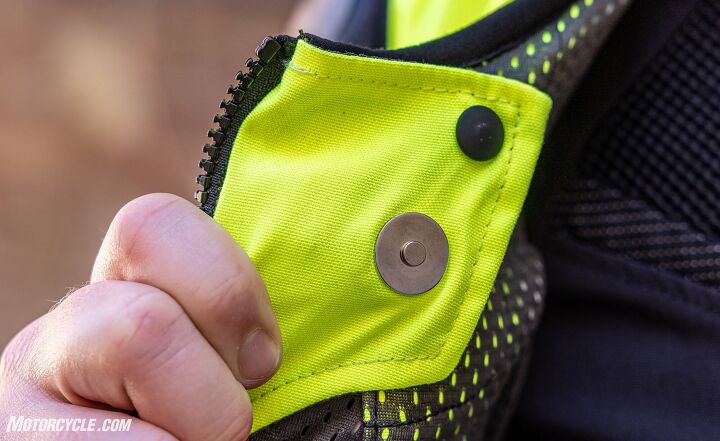
The system is activated by a magnetic closure at the top. For this gen 2 Hi Viz version, the magnetic tab can be snapped back to ensure the system doesn’t arm itself while on a hanger or in storage elsewhere – a feature not found on the Alpinestars systems or the first gen Smart Jackets.
During normal use the Smart Jacket requires the vibration from a motorcycle’s engine or speeds of 6 mph to arm the system. During my time riding the Livewire One, lack of vibration caused the system to disarm itself when stopped at traffic lights. Evans mentions in his review that he also had a very smooth running ICE motorcycle cause the same issue. Dainese is aware of this and says it’s developing a way to fix this issue currently.
Alpinestars Tech Air 3
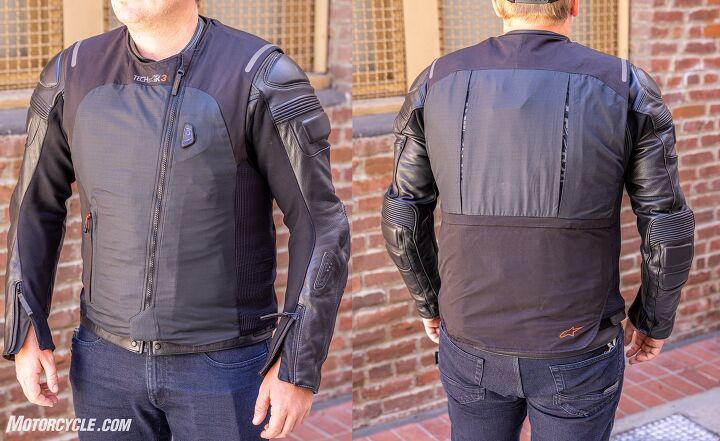
| MSRP | $600 |
|---|---|
| Sizes | Men’s XS-4XL, Women’s XS-2XL |
| Colors | Men’s Black & Yellow, Women’s Black |
| Battery Life | 40 hours |
| Weight | 3 pounds 12.7 ounces (1721 g) |
| Deployment Rate | Average 25 milliseconds |
| Modes | Street |
| Application | Tech-Air App |
| Maintenance | The system should be routinely inspected every 2 years or 500 hours of functioning by Alpinestars. Visual inspection before each use. |
| Reviewer | Ryan Adams |
The Tech-Air 3 system, like the Dainese Smart Jacket released before it, both tackle the same idea of everyday comfort and versatility by providing airbag protection within a soft, foldable vest. By comparison, the textile chassis of the TA3 feels much lighter than that of the Smart Jacket tested here – and in terms of weight, it’s actually 8 ounces lighter, too. The TA3 can fold up much smaller than the Smart jacket as well thanks to the placement of the gas canister (lower left back) and ECU (middle of the back). It also has its own strap tucked into the side of the vest to keep it rolled up when stowed. The fit of the medium TA3 is just slightly oversized which helps it fit over or under a jacket without issue. Large accordion stretch panels down both sides are key to the comfortable fit.
The Tech-Air 3 uses the same accelerometers and gyroscopes from the Tech-Air 5, but has a different airbag design. With the 3, you have collar bone, full back, and upper chest protection whereas the Tech-Air 5 offers full torso (front, back, sides, collarbones) and shoulder protection. Although the vest does not come with a hard back protector, it does have a pocket for one. The TA3 is good for one deployment and offers Alpinestars’ Street algorithm, which should be good for most riding scenarios, including some light ADV, though it is not intended for track/racing use. That said, I had no issues after spending some time on the dirt bike at speed over fairly bumpy terrain (basically a tilled up field) with a few small jumps, and drifts. Canister replacement costs $99 and if you’ve gone through your three deployments per bladder, it’ll run ya $199 to replace both.
The system is activated by a magnetic closure on the chest and includes LED and haptic notifications to let you know the system’s status. The zipper is the same as seen on the Tech-Air 5, which includes a magnetic clasp that makes starting the zipper easy. The manual says you can get 10 hours of ride time from an hour of charge. We haven’t had much time to test the Tech-Air 3 at this point, but it’s already become the easiest and most comfortable to grab for trips around town. Look for a detailed review of the Tech-Air 3 on our digital pages soon.
Alpinestars Tech Air 5
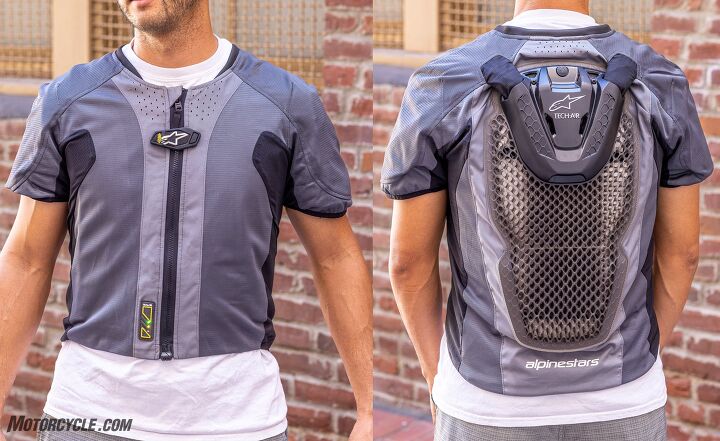
| MSRP | $750 |
|---|---|
| Sizes | Unisex XS-4XL |
| Colors | Dark Grey |
| Battery Life | 30 hours |
| Weight | 4 pounds 3 ounces |
| Deployment Rate | 20-40 milliseconds, depending on size |
| Modes | Street, Race |
| Application | Tech-Air App |
| Maintenance | Spot clean, air dry. The system should be routinely inspected every 2 years or 500 hours of functioning by Alpinestars. Visual inspection before each use. |
| Reviewer | Troy Siahaan |
The Tech-Air 5 is one of the most versatile airbag systems on the market, no matter if you’re a track rider, street rider, or even a mild off-road rider. By being completely independent, it can be worn in any jacket or suit as long as it has the required expansion space. The brains of the operation consist of three accelerometers and three gyroscopes that all monitor the body’s movement and measures it against preset algorithms to ensure the body is in the normal riding position and not doing something constituting a crash.
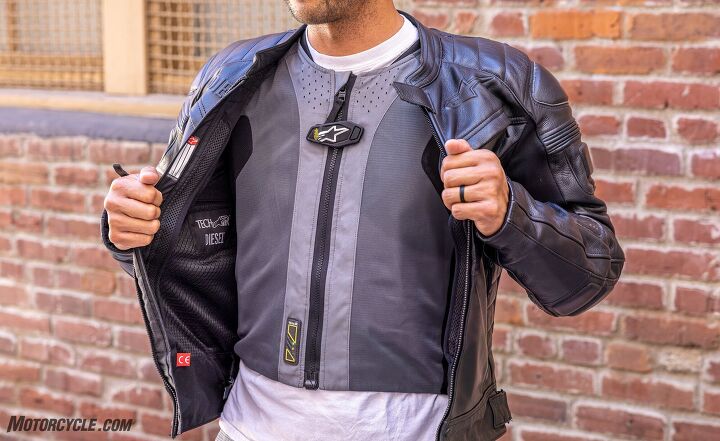
Unlike the Tech-Air 3, the TA5 is only meant to be worn under compatible jackets or race suits. A compatible jacket or suit needs to have at least 4 cm of space around the circumference of the chest to allow the airbag room to expand.
And it’s very easy to use under a riding jacket, too. Just put it on, zip it up, make sure the velcro tabs are connected, put your normal jacket on over it, and away you go. It’s a little more tricky to put on under racing leathers, but the key is to slip the vest in place inside the suit first before putting the suit on. The Tech-Air 5 also features a built-in level 1 back protector, as well – something the two previous airbags don’t have (at least not stock). For me, the Tech-Air 5’s complete upper body coverage, including the upper arm, make it my preferred everyday airbag compared to the competition. In fact, the TA5 was what I was wearing when I got hit by a car. I sustained an 18g impact to the shoulder and walked away with just a little soreness thanks to the TA5.
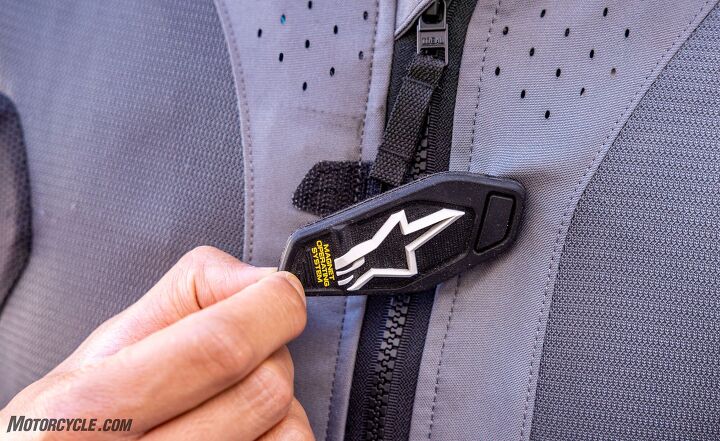
This velcro tab is located near the top of the TA5’s zipper. Connect it and the system will activate. The annoying thing about the tab is that it tends to connect when you have the vest on a hanger in your closet, not in use. Thus draining the battery unnecessarily.
On the downside, it does restrict a little bit of airflow, which can be especially problematic on hot days and/or under thick, non-vented jackets. There’s no Off switch like on some other airbag systems (or even the Tech-Air Race), which means you need to remember to separate the Velcro tabs when not in use (and keep them separated). On average, the Tech-Air 5 will deploy in 25 milliseconds, but can be as fast as 20 milliseconds for small sizes and 40 milliseconds for the 4XL. You only get one deployment with the Tech-Air 5 and then the unit needs to be sent to Alpinestars (region dependent) for replacement canisters. After three deployments, the bladder itself needs replacing.
Alpinestars Tech Air 10

| MSRP | $1,000 |
|---|---|
| Sizes | Unisex XS-3XL |
| Colors | Black/Red |
| Battery Life | 24 hours/System, 20 hours/LED panel |
| Weight | 5 pounds 0.4 ounces |
| Deployment Rate | 20-40 milliseconds, depending on size |
| Modes | Street, Race |
| Application | Tech-Air App |
| Maintenance | Remove airbag from liner and machine wash, air dry. The system should be routinely inspected every 2 years or 500 hours of functioning by Alpinestars. Visual inspection before each use. |
| Reviewer | Troy Siahaan |
The Tech-Air 10 offers what no other smart airbag system currently on the market offers: airbag protection for the hips and thighs – a very common area prone to impact and injury during a street or track crash. Otherwise, the inner workings of the Tech-Air 10 are very similar to the rest of the Tech-Air family. There are accelerometers and gyroscopes throughout the upper body and back area, but unlike other Tech-Air systems, the TA10 acts as your base layer. There are other differences between it and the other Tech-Airs, too. Apart from the base layer thing, the integrated passive back protector extends lower down the back than the TA5, for example. A Velcro waist strap activates the system, and a removable LED status panel can be placed in dedicated pockets, on the bike, or removed altogether.
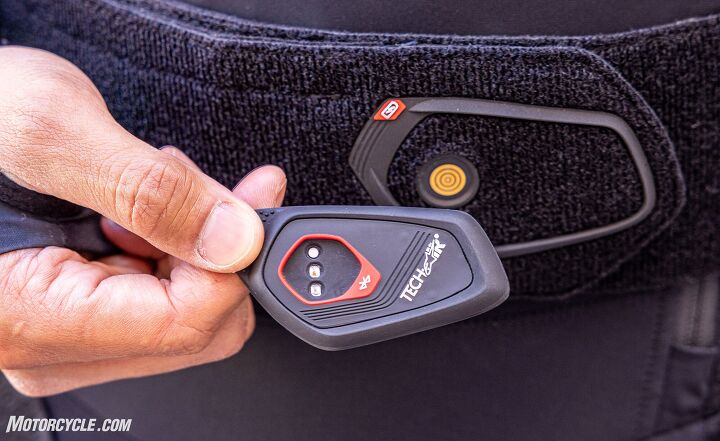
The Tech-Air 10 is activated by connecting the waist band together and the LED display will light up to tell you it’s ready. Unlike other TA systems, the LED panel on the 10 can disconnect from its base and be put in a dedicated sleeve pocket (on some Alpinestars suits), on the motorcycle itself, or can be ignored entirely. That’s not recommended, since it does tell you the state of the system.
Practically speaking, the Tech-Air 10 looks like it would restrict air flow, and while there’s definitely a noticeable difference compared to not wearing anything at all, when paired with a vented jacket (or suit) there’s a nice amount of airflow you can feel flowing up the sleeves and to the chest area. One gripe is the LED panel having a separate battery life compared to the airbag, so if you don’t use the airbag in a while and the LED panel is detached, the LED might display red to indicate the panel itself is low on battery, not the airbag. A good rule of thumb is to keep the LED attached whenever possible, charge both units the night before you plan on using it, and only detach the LED (if you choose) when the TA10 is actively in use.
Thankfully, we haven’t had the need to crash test its abilities, but the coverage it provides gives the rider peace of mind knowing they have the most complete amount of airbag protection available. On the downside, sizing can be finicky, as people with broad shoulders may need to move a size up to accommodate. This has a ripple effect of making the leather suit difficult to put on, too. In our opinion, the TA10 is well suited for racing, but can be a bit cumbersome for the street rider.
Klim In&Motion AI-1

| MSRP | $400 |
|---|---|
| Sizes | Unisex XS-3XL |
| Colors | Black/Grey |
| Battery Life | 25-plus hours |
| Weight | 3 pounds 4.8 ounces |
| Deployment Rate | “Detection and inflation under 60 milliseconds” |
| Modes | Street, Adventure, Race (currently not in US) |
| Application | In&Motion App |
| Maintenance | Spot clean, air dry. Do not let the In&Box or surrounding area come into contact with water. |
| Reviewer | Troy Siahaan |
One thing the In&Motion vest has going for it is its price. It’s significantly cheaper than its Alpinestars counterparts – but it’s not that simple. There’s a subscription service to use the airbag and to keep the algorithms up to date. You can choose from various subscription plans depending on how much you plan on using the vest, so the total cost outlay isn’t quite as clear. The heart of it all is what’s called the “In&Box.” This is a separate electronics module housing all the brains of the system. About the size of a modern smartphone, it clicks into the vest and allows it to function. Without it, the vest is simply a piece of fabric with a back protector. Where other smart airbag systems use regular updates to their algorithms based on various testing feedback, with the In&Box system we are all test riders and deliver data back for constant refinement of the algorithms. Over-the-air updates ensure each system is regularly up-to-date.

The brains of the Klim/In&Motion operation is the removable battery box. Each time the unit is turned on, it uploads data to In&Motion’s servers. The same thing happens when anyone with an In&Motion airbag activates their system. Simultaneously, the unit can download any new software updates.
The In&Motion airbag is a more traditional vest, not a vest with sleeves like the Tech-Air 5. This means you have most of the same coverage area – collarbones, ribs, back, etc. – but the omission of coverage at the shoulders/upper arms means you’re a little more vulnerable to a collarbone snap in those areas. The tradeoff is a slightly more comfortable fit underneath a jacket as there’s less bulk. This is especially handy if you choose to use the vest in Adventure mode. As the name suggests, the In&Motion can be used for light adventure riding, and if your ADV attire leans more towards MX gear, the In&Motion might be more comfortable than other options. And while Adventure mode is meant for light off-roading, In&Motion airbags have been used in the Dakar Rally by the likes of Toby Price, and there’s a new “Rally” model that features an upgraded D3O back protector and a split chest protector, too.
In&Motion claims the system can detect a crash scenario and deploy the airbag in under 60 milliseconds. Better still, the user can purchase a new CO2 cartridge and repack the system themselves, upping its convenience factor significantly. However, In&Motion says the airbag is only meant to be deployed three times before it needs to go back to an approved retailer or service center for inspection and possible replacement.
Are motorcycle airbags worth it?
Cost is a somewhat relative thing, isn’t it? For the über wealthy, price is merely a number. For a struggling college student, every penny counts. Save for one jacket on this list, each option below range from $500 and can go beyond $1100. If your financial situation makes you balk at these prices, consider for a moment the cost of an ambulance ride – or worse, a helicopter trip should you crash and hurt yourself in an area an airbag would protect. Either one is an order of magnitude higher than any of the options seen below – and we haven’t even begun to talk about the hospital bill after they fix you. When viewed under that light, these prices are much more amenable.
What is the best motorcycle airbag jacket?
The one you’re wearing. Like virtually any other piece of protective equipment, they don’t do a thing if you’re not wearing them. Different riders will have different qualities they’re looking for. Whether it’s cost, technology, integration with their existing gear, or any number of other criteria, simply calling one airbag jacket or vest “the best” doesn’t cover the nuance of the question. Choose one that fits your needs – then hope you never have to actually use it.
What motorcycles have airbags?
As you can probably imagine, it’s much harder to integrate airbags into motorcycles than it is to integrate them into a car. This is why airbags are something we wear. However, a few different manufacturers have tested airbags on their motorcycles. Most notably, airbags were a feature on certain Honda Gold Wings.
Updates: Article text and images revised September 2022
Additional Resources
MO Tested: Dainese Smart Jacket Review Crash Tested: Alpinestars Tech-Air 5 Airbag System MO Tested: Alpinestars Tech-Air 10 Review MO Tested: In&Motion Airbag VestWe are committed to finding, researching, and recommending the best products. We earn commissions from purchases you make using the retail links in our product reviews. Learn more about how this works.
Become a Motorcycle.com insider. Get the latest motorcycle news first by subscribing to our newsletter here.
The post Best Motorcycle Airbag Jackets appeared first on Motorcycle.com.
Copyright
© Motorcycle.com


